Who Controls the User Experience? AMD’s Carrizo Thoroughly Tested
by Ian Cutress on February 4, 2016 8:00 AM ESTGaming Benchmarks: 3DMark and Rocket League
Due to timing we were only able to run a couple of gaming tests, namely parts of the 3DMark suite and our Rocket League test. A reminder of our systems, including their graphics:
| System Overview | ||||
| µArch | APU + GPU | Memory | Channel | |
| HP Elitebook 745 G2 | Kaveri | A10 PRO-7350B (19W) R6, 384 SPs, 533 MHz |
8 GB | Dual |
| HP Elitebook 745 G3 | Carrizo | PRO A12-8800B (15W) R7, 512 SPs, 800 MHz |
4 GB | Single |
| Toshiba Satellite E45DW-C4210 |
Carrizo | FX-8800P (15W) R7, 512 SPs, 800 MHz |
8 GB | Single |
| HP Pavilion 17z-g100 |
Carrizo | A10-8700P (15W) R6, 384 SPs, 800 MHz |
8 GB | Single |
| Lenovo Y700 | Carrizo | FX-8800P (15W) R7, 512 SPs, 800 MHz R9 385MX, 512 SPs, 900-100 MHz |
16 GB | Single |
One of the biggest issues we’ll see here is the effect of dual channel memory on gaming. The Kaveri system used has a chipset solution that supports dual graphics, but also two memory modules installed. The Carrizo systems either came pre-prepared with one module installed or do not support dual channel memory full stop. This latter point is the main kick in the teeth, especially for a company like AMD that prides itself on gaming – the issue here is down to pin compatibility between Carrizo and Carrizo-L. As the latter only supports single channel, an OEM will design one motherboard to support both platforms (whether they are used for both or not). If a motherboard supports Carrizo-L, then it will not ever support dual channel memory, and any Carrizo APU that is used will be crippled.
Technically the Lenovo Y700 gets around this (hands up if you ever see a Carrizo-L based Y700 please) by equipping the system with a discrete graphics card and disabling Crossfire, so this system will still ultimately win in our tests due to the discrete card. The downside of this augmentation is the higher power draw, which would matter if our Y700 sample had a battery (the retail units come with a 60 Wh battery).
3DMark
3DMark is Futuremark's premium software, developed to tax systems at various different performance levels. The software contains several benchmarks as a result, with some focusing more on smartphone use all the way up to 4K, quad-SLI systems with as many in-game and post processing effects as you can throw at it. The base test, Ice Storm, is actually a good indicator of GPU scaling performance, but we also test Cloud Gate, Sky Diver and Fire Strike to get a measure of all of our systems.
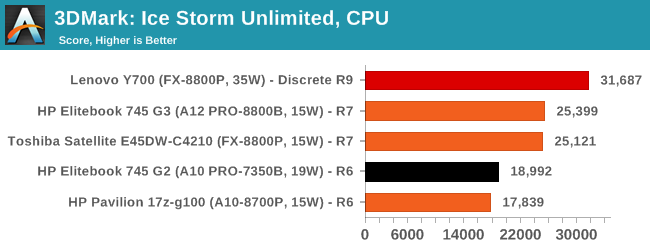
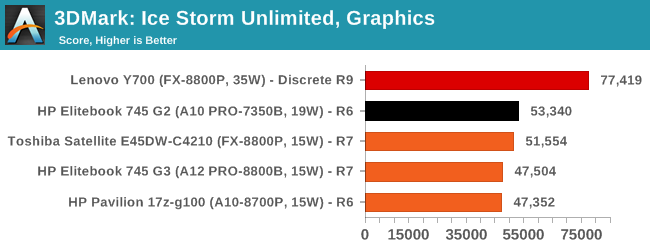
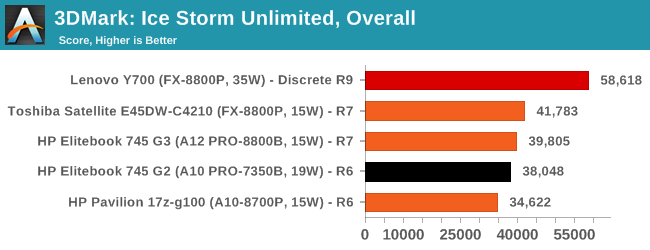
The easiest test, Ice Storm, shows the performance benefits of the Carrizo APUs in the CPU stage, although the dual channel memory for the Kaveri kicks in and gives it the graphics lead. The overall scores however benefit from that high CPU boost, so Carrizo at 15W on single channel wins this round.

Moving up in difficulty to Cloud Gate puts dual channel Kaveri in the lead, although the Toshiba is holding on a bit with its higher thermal skin temperature limit.
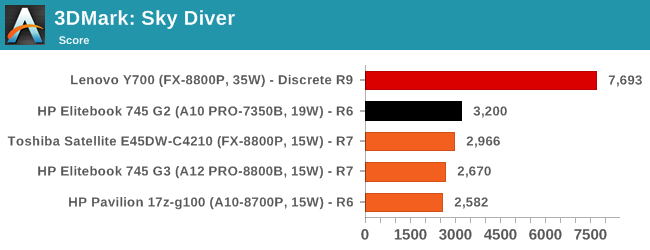
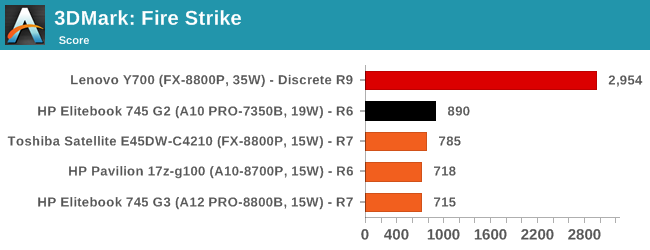
The last two benchmarks fall square with the dual channel configuration. The GDDR5 of the discrete graphics card in the Y700 wins out on all of them.
Rocket League
Hilariously simple pick-up-and-play games are great fun. I'm a massive fan of the Katamari franchise for that reason — passing start on a controller and rolling around, picking up things to get bigger, is extremely simple. Until we get a PC version of Katamari that I can benchmark, we'll focus on Rocket League. Rocket League combines the elements of pick-up-and-play, allowing users to jump into a game with other people (or bots) to play football with cars with zero rules. The title is built on Unreal Engine 3 and it allows users to run the game on super-low-end systems while still taxing the big ones. Since the release earlier in 2015, it has sold over 5 million copies and seems to be a fixture at LANs and game shows.
With Rocket League, there is no benchmark mode, so we have to perform a series of automated actions. We take the following approach: Using Fraps to record the time taken to show each frame (and the overall frame rates), we use an automation tool to set up a consistent 4v4 bot match on easy, with the system applying a series of inputs throughout the run, such as switching camera angles and driving around. It turns out that this method is nicely indicative of a real bot match, driving up walls, boosting and even putting in the odd assist, save and/or goal, as weird as that sounds for an automated set of commands. To maintain consistency, the commands we apply are not random but time-fixed, and we also keep the map the same (Denham Park) and the car customization constant. We start recording just after a match starts, and record for 4 minutes of game time, with average frame rates, 99th percentile and frame times all provided. For these tests, we used the 1280x720 resolution at high settings. A bigger explanation of testing can be seen in our AMD A8-7670K APU review.

Built on UE3 and DX9, the game relies heavily on single threaded performance and at this level of detail, memory bandwidth. The Kaveri takes the crown, showing that at this level adding another stick of memory (and making sure you have the right configuration) is more important than a more advanced (or perhaps expensive) APU.
We’ll go into temperatures on the next page.















175 Comments
View All Comments
yannigr2 - Friday, February 5, 2016 - link
The 845 doesn't have an iGPU. You threw away the chance to directly compare the color compression advantage of Carrizo's GPU in a very limited bandwidth scenario like this one by either removing one dimm from the Kaveri laptop or adding another one in one of the Carrizo laptops. I wouldn't ask why. Thanks for the article.FriendlyUser - Saturday, February 6, 2016 - link
Thank you for this extensive article. Many people seem to dismiss AMD CPUs today without actual data. I commend your efforts to examine all aspects of real systems. I'll be waiting for the data from 845 (which sound like a decent upgrade for a NAS...).Keep up the good work.
JMC2000 - Sunday, February 7, 2016 - link
This is something I've been interested in since AMD released the 845 (wasn't there a Phenom II-based Athlon 845? I know there was a Phenom II 845...). Shame that they chose not to release an A12/FX Carrizo APU, those 512 shaders could be nice...mczak - Friday, February 5, 2016 - link
I agree with that, it's _really_ missing results with dual channel. I understand why single-dimm configurations were tested, but at least two of the notebooks had the option to use dual channel, and even if it might be difficult to get preconfigured options with dual-channel, it's easily upgradeable - I'm also interested in what Carrizo can do as a chip, not only what it can do if sufficiently crippled by the OEM.(Not that I expect wonders with dual channel though, at least not at 15W where the graphics doesn't run with more than half the max clock anyway, but still...)
Ian Cutress - Friday, February 5, 2016 - link
On the chip side, we'll do a full breakdown of perf and IPC when we get our hands on the desktop version in Athlon X4 845. I'm hoping to get some R-Series too, and we can do DDR3 vs DDR4 on AMD as well. That might provide a better pure comparison which I know some users want to see. I do too :)bojblaz - Friday, February 5, 2016 - link
Excellent, excellent article. Lucid questions asked and answers pursued - we need more of this kind of journalism. I can't praise this enough.It would have been really interesting to see the results had you filled the second SODIMM on the laptops that supported dual channel? I assumed time constraints prevented you from doing so. Also any chance of going to the OEMs directly and asking them why they make the decisions they make?
Lolimaster - Friday, February 5, 2016 - link
That's like givin 5 tons of deadweight to pre-Raditz-Vegeta saga Goku. AMD, why even bother, release your products under Ruby brand or something...TheinsanegamerN - Thursday, February 11, 2016 - link
I second that. A proper 13 inch design with a 35 watt 8800p, none of this hybrid graphics stuff, and good battery life, would be an insta-buy. Or 14 or 15 inch. I just want something like my old lenovo e535, but smaller. It cant be THAT hard, can it?nfriedly - Sunday, February 7, 2016 - link
Agreed. This article was basically a long-winded way of saying "all current AMD laptops suck, and we aren't even sure how good they could be because *all* the OEMs half-assed their designs"I, for one, would be very interested in an AMD designed laptop.
Cryio - Sunday, February 7, 2016 - link
Apparently AMD wants to push 28 nm even farther with Bristol Ridge, maybe better binned chips and hopefully DDR4 support will provide a much needed boost.